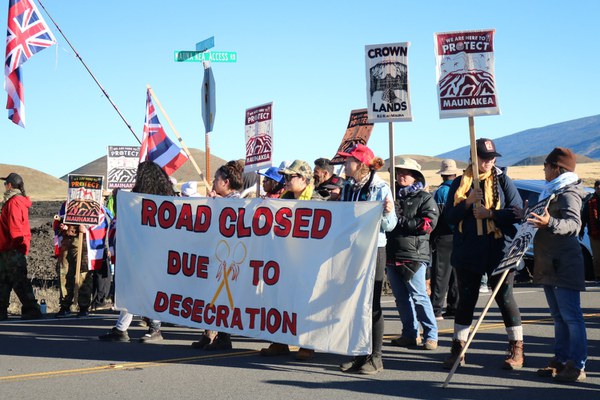Caitlin Blanchfield, PhD candidate in architectural history at Columbia University’s Graduate School of Architecture, Planning, and Preservation, was a junior fellow in Garden and Landscape Studies in 2021–2022. Her research report, “Unsettling Colonial Science: Modern Architecture and Indigenous Claims to Land in North America, 1947–1993,” examined forms of settler colonialism in North America through federally funded observatories and other research projects.
Q&A with Caitlin Blanchfield
What sites of settler-colonialist scientific endeavors are you studying?
I’m looking at three sites, two of which are astronomical research observatories in what is now called the United States. One is the Kitt Peak Observatory on the Tohono O’odham Nation in southern Arizona, the other is the Maunakea Observatories on the volcano Maunakea on Hawai‘i Island. The third site is a research laboratory in the Arctic in the town of Inuvik on Inuvialuit and Gwich‘in land, formerly called the Inuvik Research Laboratory, now called the Western Arctic Research Center. These sites, while having distinct histories and presents, are places where we can trace or understand how processes of settler-colonial governance during the twentieth century unfolded, and specifically how the governments of the United States and Canada appropriated Indigenous lands by using large-scale Cold War-era scientific research infrastructure.
What do the past and ongoing conflicts at these sites reveal?
Settler colonialism is generally seen as something foundational to both the American and Canadian governments but also historical—something that happened in the eighteenth and nineteenth centuries. Yet settler colonialism is also an ongoing process that persists into the present. It’s important to understand what the tactics and techniques of this process were in our more recent history, and how something like science—which doesn’t necessarily seem like an insidious pursuit—is enmeshed in the same colonial government structures while self-consciously claiming neutrality and universal value.
Maunakea, for example, remains a site of active contestation on the part of kia‘i, or “protectors of the mountain,” from across the islands and around the world. My research focuses on the longer history of the movement, narrating opposition to the initial development and later expansion of this observatory. Since the 1970s, Indigenous community members and other grassroots environmental activists have worked together to publicly question the permitting and environmental review processes and their outcomes to protect the unique ecology of this sacred place. The land the observatory now sits on was so-called crown and government land, part of the Hawaiian government before it was illegally overthrown. The US took control of the land and leased it University of Hawaii for a dollar a year for sixty-five years. The university then subleases it out to different telescope consortiums to develop.
Because the mauna is conservation land and was previously protected forest land, permitting processes and environmental review processes were required to build these large telescopes. Through these processes a certain definition of “environment” was produced by those in power and by those interested in developing the mountain to enable scientific interests, such as the state of Hawai‘i Department of Land and Natural Resources, the University of Hawai‘i, NASA and the NSF, and the planning firms they hired for these reports. Environmental impact statements state the telescope would provide benefits to other telescopes and infrastructure already on the mountain or other commercial ventures in the area. This definition of “environment” does not center the actual land and certainly does not consider Indigenous Kanaka Maoli understandings of place and landscape.
What do these histories reveal about the dynamics of so-called science and traditional knowledge?
Today, the astronomy corporation that wants to build the Thirty Meter Telescope on Mauna Kea (the TMT International Observatory, LLC) has created a narrative that there is a dichotomy between science and Indigenous knowledge or religion and that the people who do not support the telescope don’t understand the scientific work that will be done there. This is reductive and racist. The kia‘i I’ve spoken with and whose work I’ve read insist that the mauna is a site where Kanaka Maoli science and knowledge gathering has been practiced for literally thousands of years. It’s a site of traditional star navigation, so astronomy is actually being impeded by these telescopes because they block the alignment of certain star configurations. There are also many Kanaka scientists who don’t think Maunakea is an appropriate location for the TMT. It’s a questions of land rights, not of scientific knowledge.
The TMT also threatens ecosystems and hydrology on the island. Preserving them is science too—endangered species like the wekiu bug or the palila bird live on the mountain. The protests have long been about protecting the ecological system as well as the right to use the land, rooted in Indigenous scientific knowledge that is not necessarily at odds with modern “science.” At Dumbarton Oaks it’s been helpful to talk with people who have a background in history of science, like Marlis Hinckley, or are doing related work in Pre-Columbian Studies.
May Wang was the 2020–2022 postgraduate writing and reporting fellow. Photo courtesy of Caitlin Blanchfield. “Road Closed due to Desecration,” Kia‘i block the Mauna Kea Access Road. Photograph by Kapulei Flores (kapzphotography).

